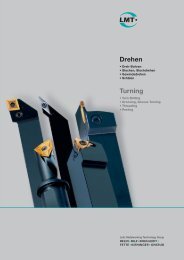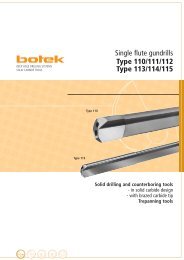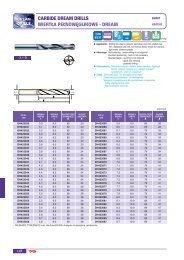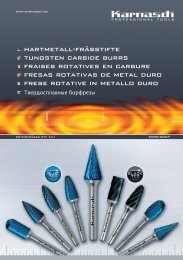Gear Cutting Tools
Hobs - Torion
Hobs - Torion
- No tags were found...
You also want an ePaper? Increase the reach of your titles
YUMPU automatically turns print PDFs into web optimized ePapers that Google loves.
Hobs for producing straight- and helical-tooth spur<br />
gears with involute flanks<br />
The fundamental geometrical concepts<br />
of a spur gear hob for generating<br />
gears with involute flanks are<br />
laid down and explained in detail<br />
in DIN 8000. According to this, the<br />
basic body of a hob is always a<br />
worm. If this worm is now provided<br />
with flutes, cutting teeth result.<br />
These become capable of cutting<br />
by being backed off or relieved.<br />
This relieving operation is carried<br />
out on machine tools specially developed<br />
for this process; it is very<br />
time consuming and therefore also<br />
expensive. For hobs to moderate<br />
accuracy specifications, relief<br />
turning is sufficient; for stricter<br />
quality requirements the hob is relief<br />
ground.<br />
Generally, relief turned hobs<br />
achieve quality class B approximately<br />
to DIN 3968. Relief ground<br />
hobs achieve quality classes A, AA<br />
and higher. The highest quality<br />
class in DIN 3968 is AA. For exceptionally<br />
high quality requirements<br />
it is usual to restrict the tolerances<br />
of quality class AA still<br />
further. Quality class corresponding<br />
to AAA to DIN 3868, without<br />
comment, means the restriction to<br />
75 % of the AA tolerances for all<br />
measurable variables.<br />
If special tolerance restrictions of<br />
the AA tolerance are required, this<br />
is also done with the AAA reference,<br />
but the individual measurable<br />
variables and the tolerance<br />
restriction are now given in % or<br />
directly in µm. E.g. quality class<br />
AAA to DIN 3968, item nos. 16 and<br />
17 restricted to 50 % of the tolerance<br />
of AA.<br />
The purpose of hob tolerances is<br />
to assign the tools to a quality<br />
class according to their accuracy.<br />
On the basis of the hob quality<br />
classes, the expected gear quality<br />
can then be forecast.<br />
Not all requirements aimed at a<br />
”good gear quality“ in the wider<br />
sense, e.g. very quiet running or a<br />
specific addendum- and dedendum<br />
relief are achieved solely<br />
through a high cutter quality. For<br />
such needs, hobs with a defined<br />
crowning depth have proved successful.<br />
Depending on the load<br />
and the required gear performance,<br />
the suitable crowning<br />
depth can be selected from the<br />
various tables N102S, N102S/3 or<br />
N102S/5. It must be noted that the<br />
tool depth crowning is not transmitted<br />
completely to the gear. The<br />
lower the number of teeth of the<br />
gear, the less the effective convexity<br />
portion.<br />
involute with<br />
top convexity<br />
Tolerances for hobs with special class tolerance values in 1 /1000 millimetres<br />
N 102 S<br />
N 102 S/3<br />
N 102 S/5<br />
Module<br />
Tolerance range<br />
0,63–1 1–1,6 1,6–2,5 2,5–4 4–6,3 6,3–10 10–16 16–25 25–40<br />
F fS fo 25 28 32 36 40 50 63 80 100<br />
F fS fu 12 14 16 18 20 25 32 40 50<br />
F fS o 4 4 4 5 6 8 10 12 16<br />
F fS u 0 0 0 0 0 0 0 0 0<br />
F fS ao 16 16 16 20 24 32 40 50 64<br />
F fS au 8 8 8 10 12 16 20 25 32<br />
F fS fo 12 14 16 18 20 25 32 40 50<br />
F fS fu 8 8 8 10 12 16 20 25 32<br />
F fS o 4 4 4 5 6 8 10 12 16<br />
F fS u 0 0 0 0 0 0 0 0 0<br />
F fS ao 12 14 16 18 20 25 32 40 50<br />
F fS au 8 8 8 10 12 16 20 25 32<br />
F fS fo 8 8 8 10 12 16 20 25 32<br />
F fS fu 4 4 4 5 6 8 10 12 16<br />
F fS o 0 0 0 0 0 0 0 0 0<br />
F fS u 0 0 0 0 0 0 0 0 0<br />
F fS ao 8 8 8 10 12 16 20 25 32<br />
F fS au 0 0 0 0 0 0 0 0 0<br />
F fs F<br />
fo fS fo<br />
F fs F<br />
fu fS fu<br />
Tolerance range<br />
F fS fo<br />
F fS ao<br />
F fS au<br />
Tool root section<br />
F fS fu<br />
Form deviation of<br />
the cutting edge<br />
Tool tooth tip<br />
10









